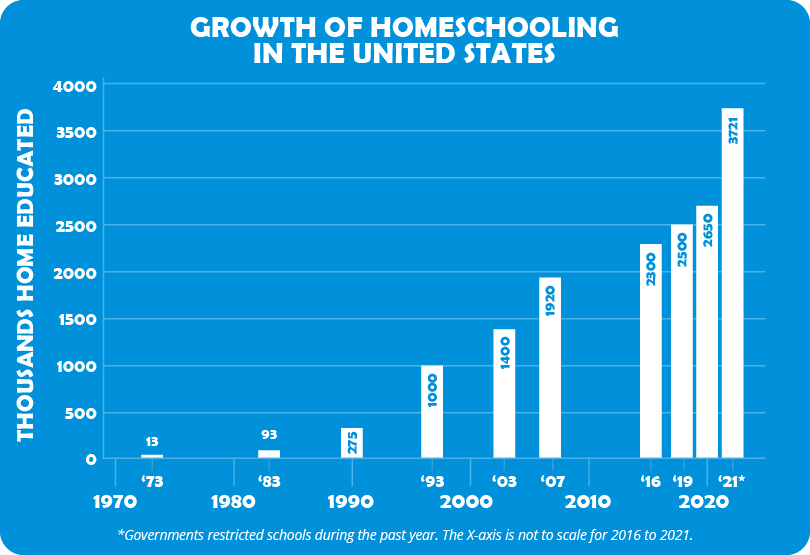Check out the Latest 100+ Homeschooling Statistics 2024.
According to the most recent data made available by the federal government, between 3 and 4% of the population of school-aged children in the United States is educated at home.
There are 51% of female homeschooled pupils compared to 49% of male homeschooled children.
The majority of homeschooled children are white, which accounts for 68% of the overall student population. Hispanics make up 15% of the total population, making them the second largest group. 8% of the population of homeschooled pupils are students of African descent, whereas just 4% are students of Asian descent.
As of February 2020, an estimated total of at least 9 million Americans have participated in some form of homeschooling at some point in their lives.
Up until 2019, the annual growth rate of the number of students receiving an education at home ranged between 2 and 8%.
The number of pupils that received their education at home increased from 3.4% in the fall of 2019 to 9% in the fall of 2020.
Homeschooling Statistics in General from Around the World
The United States is one of many countries across the world that recognizes the legitimacy of homeschooling. The countries of Indonesia, China, Japan, Botswana, South Africa, Australia, Greece, Hungary, Mexico, Brazil, and Canada are a few more that fit this category.
The process of educating a child at home rather than sending them to a traditional institution of higher learning is known as homeschooling.
Students are considered to be receiving a home education if they are educated at home rather than at school for at least some portion of their learning or if they attend school less than 25 hours per week as part-time students. Homeschooling can also refer to students who attend school less than full-time but still receive an education.
Statistics on Students’ Academic Achievement When They Are Homeschooled
The following is what the National Home Education Research Institute has to say about it:
- On average, homeschooled children score 15 to 30% higher on standardized tests than those who attend public or private schools.
- The academic success of a child who receives instruction at home is not reliant on whether or not the parent who provides the instruction is credentialed as a teacher.
- It has been demonstrated that children who are educated at home achieve higher test scores, regardless of the official education level of their parents.
- On standardized tests like the ACT and SAT, children who are educated at home typically have higher scores than the typical student.
- There are around 2.2 million youngsters in the United States that are receiving their education at home at this time.
- The number of people choosing to receive their education at home has increased over the previous few years at a rate that is almost equivalent to 8% every year.
Families that opt to educate their children at home are not reliant on public schools or the financial support of taxpayers to pay for their children’s education. In point of fact, the costs associated with homeschooling account for around 24 billion dollars worth of savings that are passed on to taxpayers in the form of reduced educational costs.
Students who receive their education at home are expected to take an active role in community life through activities like as voting, giving their time to volunteer organizations, socializing, and attending public meetings.
Reasons And Motivations For Home Educating
The majority of children and their families make the decision to homeschool for more than one reason. The following are some of the most frequently cited justifications for homeschooling:
- Personalize or differentiate the teaching methods and the atmosphere of the classroom for each student.
- achieve more academic success outside of school than inside of it.
- Using methods of teaching that are different from those that are typically used in traditional institutions,
- improve the connections inside the family, both between the children and their parents and among themselves,
- and create social connections that are directed and reasoned with young people’s peers as well as adults,
provide a safer environment for children and youth, because of the physical violence, drugs and alcohol, psychological abuse, racism, and improper and unhealthy sexuality associated with institutional schools, and as an alternative education approach when public or private institutional schools are closed due to acute health situations such as those related to disease; provide a safer environment for children and youth; provide a safer environment for children and youth; provide a safer environment for children and youth; provide a safer environment for children and youth; (e.g., Covid-19, Coronavirus)
Protect students from minority groups who may be subjected to racism in public schools or who may have lesser expectations placed upon them. For example, black youngsters (e.g., Fields-Smith, 2020; Mazama & Lundy, 2012).
children and young people should be taught and inculcated with a specific set of values, ideas, and worldview.
The Effects That COVID-19 Will Have On Homeschooling Across the United States
- The COVID-19 Pandemic caused a significant disruption in educational pursuits all throughout the world, especially in the United States.
- As of May 2020, there is an expectation that 41% of parents will be open to the idea of letting their children participate in homeschooling.
- The results of an IPSOS study that was carried out in May 2020 showed that 59% of the parents were open to the idea of homeschooling, with 30% giving it serious consideration.
- In the years leading up to the COVID-19 Pandemic, homeschooling was chosen by 28% fewer parents.
- After the epidemic began, there was a 43% increase in the number of parents who were considering homeschooling their children.
- There is a belief by 53% of black parents that the pandemic favorably changed their attitudes on homeschooling in 2020.
- As of February 2020, 26% of parents who had never attempted homeschooling before were considering homeschooling their children full-time. During the same period, 33% of people were thinking of only completing it in part.
- An unsatisfactory experience for only 68% of the parents who had homeschooled their children prior to February 2020.
- Homeschooling was deemed to be satisfactory by 83% of the parents who had never used the method prior to February 2020.
- Before the pandemic, 69% of the pupils who were receiving their education at home indicated that they were willing to continue receiving it in the same manner for the subsequent school year.
- 15% of the parents who did not homeschool their children in February 2020 were extremely likely to homeschool their children entirely in the next academic year. This was the case among the parents who did not homeschool their children.
- Prior to February 2020, parents who were homeschooling their children were likely to continue doing so on a full-time basis in their children’s next academic year. This percentage was at 54%.
- The expense to the parent or parents of homeschooling one child is from $700 and $1,800 annually on average.
- The annual expenditure of the parent(s) is typically in the range of $350-$750.
- The annual expense for materials is somewhere in the range of $150 to $300.
Costs associated with annual field trips range between $100 and $250.
Data on Number of Hours HomeSchool Students Learn
| Hours in a week | Percentage of students |
| 5 hours each week | 72% |
| 4 hours weekly | 12% |
| 6 hours weekly | 4% |
| 7 hours weekly | 3% |
| 3 hours weekly | 4% |
| 2 hours weekly | 2% |
| 25 to 40 hours weekly | 50% |
| 11 to 24 hours | 28% |
| 1 to 10 hours | 21% |
HomeSchooling State By State
Here is a quick stats of state by state comparison:
| State | Percentage of Homeschooled Students From Overall Students In 2021. | 2021 HomeSchooled Students |
| North Carolina | 10.6% | 179,900 |
| Florida | 4.6% | 143,431 |
| Georgia | 4.6% | 85,510 |
| Virginia | 4.8% | 65,571 |
| Washington | 3.3% | 39,843 |
| Wisconsin | 3.2% | 31,878 |
| Minnesota | 3.2% | 30,955 |
| South Carolina | 3.4% | 28,316 |
| Massachusetts | 1.7% | 17,127 |
| Nebraska | 4.3% | 14,780 |
Conclusion
If you’re still uncertain about whether to homeschool your child or not, I recommend consulting the aforementioned general statistics about homeschooling. Hopefully, this article has provided you with a comprehensive understanding of homeschooling statistics in the US. Feel free to share your thoughts in the comments section below.
You can also check the below stats:



